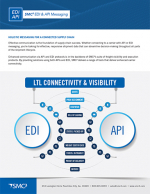SMC³’s CzarLite XL: The Case for a Re-Indexed LTL Benchmark Pricing System
This paper takes a deep dive into SMC³’s CzarLite XL, an advanced pricing system solution that gives shippers, logistics service providers and carriers a new neutral benchmark choice when negotiating LTL shipping rates.
The Call for another LTL Rating Option
Less-than-truckload transportation in today’s world is significantly different than it was even 10 years ago.
As the United States economy has shifted from one based on manufacturing to centering more on services, population centers have shifted, changing the domestic flow of freight.
Some manufacturing has moved from the highcost areas of the northern states to the southeastern region.
Offshore manufacturing has increased container traffic through West Coast and East Coast ports, creating a national network of distribution centers for major retailers.
This freight-flow shift and a host of other factors have changed the LTL landscape.
LTL is extremely vital to the supply chain, but the shipment-rating process is awash in complexity; pricing out freight shipments that don’t fill an entire trailer is inherently challenging.
Freight that takes up less space than an entire truckload is most often rated using a classification metric - in a sense, providing shipments with a generalized price point based on the type of good shipped.
Over time, shippers and carriers have negotiated massive discounts on top of these class-based rates, sometimes arranging discounts that reach 85 percent or more; other discounts are extremely complex and pin-point specific down to the fifth decimal place.
To make all of this a bit easier to digest, carriers, shippers and third-party logistics companies have developed discount structures; these include freight-all-kinds agreements, which allow shippers to send all of their freight under one agreed-upon class.
This takes the classification guesswork out of moving freight around the country, but also creates added complexity because numerous classification ratings for each shipment have been turned into a single generalization that doesn’t account for the actual costs of doing business.
One way shippers and logistics service providers should begin carrier rate negotiations is with a neutral tariff that has been re-indexed to reflect modern market conditions. This tariff, which approximates the market price of shipping, differs from carrier and shipper tariffs because it is unbiased and not skewed toward any company’s transportation network.
Shippers who currently use SMC³’s neutral CzarLite® base rate, and who have agreements with multiple carriers in place, might not see the need to re-index; it works for them, so they don’t want to change it.
However, some in the marketplace have been demanding a re-indexed rate. In a reindexed rate, the numbers change, but their relationship relatively stays the same. For example, a shipper or logistics service provider using base rate “A” has a contractual discount of 85.76 percent off the rate – implying that the rate is artificially high.
It also may complicate how the base rate is implemented into the shipper’s or LSP’s transportation management system.
Many shippers use TMS programs that aren’t capable of calculating discounts on such a minute scale.
What’s Related



Favorites





